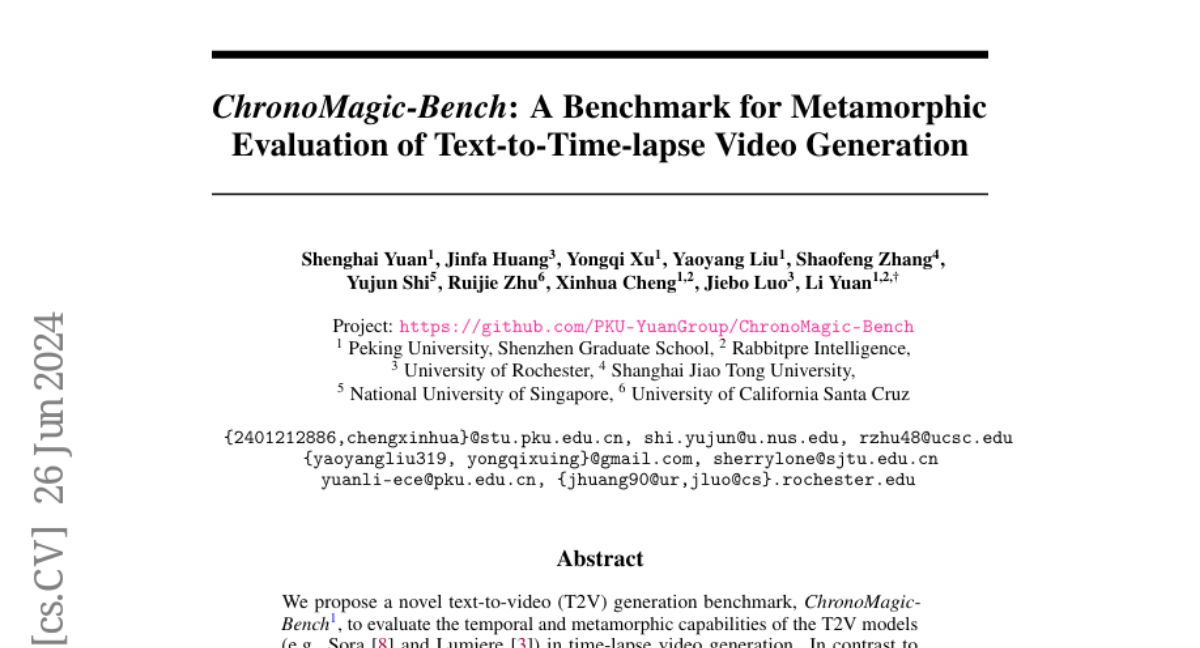ChronoMagic-Bench: A Benchmark for Metamorphic Evaluation of Text-to-Time-lapse Video Generation
Shenghai Yuan, Jinfa Huang, Yongqi Xu, Yaoyang Liu, Shaofeng Zhang, Yujun Shi, Ruijie Zhu, Xinhua Cheng, Jiebo Luo, Li Yuan
2024-06-27

Summary
This paper introduces ChronoMagic-Bench, a new benchmark designed to evaluate how well text-to-video (T2V) models can create time-lapse videos. It focuses on the models' ability to handle complex changes over time and maintain a logical flow in the videos.
What's the problem?
Existing benchmarks for evaluating T2V models often concentrate on how visually appealing the videos are or how well they match the text descriptions. However, they do not adequately assess the models' abilities to generate time-lapse videos that show significant changes over time (metamorphic amplitude) and ensure that these changes make sense and are coherent (temporal coherence). This gap means that we don’t fully understand how well these models perform in real-world scenarios where time-lapse generation is needed.
What's the solution?
ChronoMagic-Bench addresses this issue by introducing a comprehensive evaluation system that includes 1,649 prompts and real-world video references. The prompts are categorized into four main types of time-lapse videos: biological, human-created, meteorological, and physical phenomena, with further divisions into 75 subcategories. To measure the effectiveness of the generated videos, two new metrics were developed: MTScore, which assesses how much change occurs over time, and CHScore, which checks if the video maintains a logical flow. The benchmark also includes a large dataset called ChronoMagic-Pro with 460,000 high-quality time-lapse video pairs and detailed captions.
Why it matters?
This research is important because it provides a more thorough way to evaluate T2V models, particularly for applications that require generating time-lapse videos. By focusing on metamorphic changes and temporal coherence, ChronoMagic-Bench helps identify the strengths and weaknesses of different models, guiding improvements in video generation technology. This can lead to better tools for filmmakers, educators, and scientists who rely on accurate visual representations of changes over time.
Abstract
We propose a novel text-to-video (T2V) generation benchmark, ChronoMagic-Bench, to evaluate the temporal and metamorphic capabilities of the T2V models (e.g. Sora and Lumiere) in time-lapse video generation. In contrast to existing benchmarks that focus on the visual quality and textual relevance of generated videos, ChronoMagic-Bench focuses on the model's ability to generate time-lapse videos with significant metamorphic amplitude and temporal coherence. The benchmark probes T2V models for their physics, biology, and chemistry capabilities, in a free-form text query. For these purposes, ChronoMagic-Bench introduces 1,649 prompts and real-world videos as references, categorized into four major types of time-lapse videos: biological, human-created, meteorological, and physical phenomena, which are further divided into 75 subcategories. This categorization comprehensively evaluates the model's capacity to handle diverse and complex transformations. To accurately align human preference with the benchmark, we introduce two new automatic metrics, MTScore and CHScore, to evaluate the videos' metamorphic attributes and temporal coherence. MTScore measures the metamorphic amplitude, reflecting the degree of change over time, while CHScore assesses the temporal coherence, ensuring the generated videos maintain logical progression and continuity. Based on the ChronoMagic-Bench, we conduct comprehensive manual evaluations of ten representative T2V models, revealing their strengths and weaknesses across different categories of prompts, and providing a thorough evaluation framework that addresses current gaps in video generation research. Moreover, we create a large-scale ChronoMagic-Pro dataset, containing 460k high-quality pairs of 720p time-lapse videos and detailed captions ensuring high physical pertinence and large metamorphic amplitude.